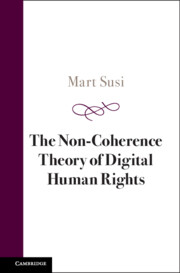Book contents
- The Non-coherence Theory of Digital Human Rights
- The Non-coherence Theory of Digital Human Rights
- Copyright page
- Contents
- Acknowledgements
- Introduction
- Part I The Contextual Challenges and Purpose of the Non-coherence Theory of Digital Human Rights
- Part II Reflections on Some Theories and Doctrines
- Part III The Core Elements of Non-coherence Theory
- 13 Doctrinal Changes in Scope and the Meaning of Human Rights
- 14 The Variance Principle and Digital Transparency
- 15 Legal Certainty and Uncertainty
- 16 On Foreseeability and Non-foreseeability
- 17 Reflections from the Academic Debate
- Part IV The Impact of the Non-coherence Theory
- Part V Internet Balancing Formula
- In Lieu of the Concluding Remarks
- Index
16 - On Foreseeability and Non-foreseeability
from Part III - The Core Elements of Non-coherence Theory
Published online by Cambridge University Press: 22 February 2024
- The Non-coherence Theory of Digital Human Rights
- The Non-coherence Theory of Digital Human Rights
- Copyright page
- Contents
- Acknowledgements
- Introduction
- Part I The Contextual Challenges and Purpose of the Non-coherence Theory of Digital Human Rights
- Part II Reflections on Some Theories and Doctrines
- Part III The Core Elements of Non-coherence Theory
- 13 Doctrinal Changes in Scope and the Meaning of Human Rights
- 14 The Variance Principle and Digital Transparency
- 15 Legal Certainty and Uncertainty
- 16 On Foreseeability and Non-foreseeability
- 17 Reflections from the Academic Debate
- Part IV The Impact of the Non-coherence Theory
- Part V Internet Balancing Formula
- In Lieu of the Concluding Remarks
- Index
Summary
The non-reflective and simplistic application of the non-coherence assumption leads to an automatic statement that foreseeability transforms into non-foreseeability online. The proponent of simplicity could argue that when the offline human rights normative domain is by and large characterised by foreseeability, the online realm is characterised by the opposite, non-foreseeability. Yet there is no rule according to non-coherence theory saying that specific features characterising rights offline turn into the opposite online. Variance in features can produce a multitude of non-coherent images, exhibiting a weakening or strengthening of the features, but also turning them into the opposite. If foreseeability were to turn into its opposite upon transposition to the online domain, and such transformation could be validated, then this positions foreseeability exclusively in the offline rights domain. The consequences of such exclusivity would be in terms of valuability and usability. Foreseeability exists online in more extreme formats than offline, to a considerably higher and lower degree. Because of this particularity, the image of foreseeability online is unclear.
Keywords
- Type
- Chapter
- Information
- The Non-Coherence Theory of Digital Human Rights , pp. 196 - 202Publisher: Cambridge University PressPrint publication year: 2024

